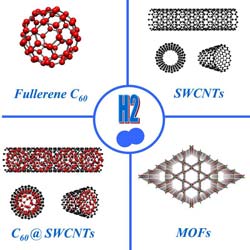The search for new materials for hydrogen storage

Caption: Four types of materials studied in the dissertation: fullerene C60, carbon nanotubes, metal-organic frameworks (MOFs), and fullerene C60 encapsulated inside carbon nanotubes.<br>
New car engines that run on hydrogen produce only water as exhaust and are three to four times more efficient than ordinary internal combustion engines. Just one “small” problem is hampering the development of hydrogen-powered vehicles: there is no good method for storing sufficient amounts of hydrogen, as it is a gas of very low density.
Serhiy Luzan devotes the first part of his dissertation to studies of hydrogen storage in exciting new types of materials: metal-organic frameworks (MOFs). They consist of zinc- and cobalt-based metal clusters linked together via organic linkers, and they are extremely porous. One gram of MOF has a hydrogen-absorbing surface that is larger than a football field! Dozens of new MOF materials are synthesized each year, which is highly promising for the next generation of hydrogen storage materials.
Serhiy studied the hydrogen absorption of several new MOFs and researched the effects of different surface areas, pore volumes, and pore forms on the hydrogen storage parameters. MOFs can store record amounts of hydrogen at very low temperatures, but the hydrogen capacity at room temperature is not good enough. Luzan therefore studied new methods to enhance this capacity. Addition of metal catalysts has previously been reported to improve hydrogen storage considerably.
“But in my study, the effect of metal catalysts addition on hydrogen absorption in MOFs was not confirmed,” says Serhihy Luzan.
Hydrogen is of interest not only as a fuel but also for chemical modification of nano-structured carbon materials, such as carbon nanotubes, fullerenes, and graphene. Graphene is a single layer of carbon atoms. Carbon nanotubes also consist of pure carbon, in the form of graphene layers rolled into a cylinder. Fullerene, C60, consist of sixty carbon atoms arranged in five- or six-vertices figures, just like the pattern on a soccer ball. There are carbon materials that are stronger than steel, conduct current better than copper, and diffuse heat better than diamond.
In the second part of the dissertation Luzan describes the materials he created by the reaction of hydrogen with fullerenes and carbon nanotubes.
Luzan studied the reaction between fullerene C60 and hydrogen at elevated temperatures and hydrogen pressures, with and without the addition of metal catalysts. The reaction resulted in the formation of hydrogenated fullerenes, C60Hx. Upon extended hydrogen treatment, the fullerene structure fragmented and collapsed. This outcome shows that it is possible to break down fullerenes stepwise into smaller cup-like molecules, which are stabilized by hydrogen atoms. This is a structure that was previously difficult to achieve.
“With this method, we should be able to use fullerenes as a relatively inexpensive source material for creating new molecules that hopefully would retain interesting properties from the original carbon nano-material,” says Serhihy Luzan.
Hydrogenated graphene (graphane) is expected to be an ideal material for new carbon-based electronics, but graphane is difficult to synthesize by a direct reaction between graphene and hydrogen. It is much easier first to hydrogenate carbon nanotubes and then to cut them along the tube axis into so-called nanoribbons, which have hydrogen covalently bonded to the surface.
Luzan’s experiments showed that the reaction between single-wall carbon nanotubes and hydrogen is possible if a suitable catalyst is used, and he was able to observe that some of the nanotubes were converted to graphene or graphane nanoribbons.
About the public defense:
On Friday, September 28, Serhiy Luzan, Department of Physics, will defend his thesis titled: Materials for hydrogen storage and synthesis of new materials by hydrogenation. Title in Swedish: Material för vätelagring och syntes av nya material genom hydrering.
The public defense will take place at 1:00, p.m. in room N300.
The external examiner is Prof. Dr. Yaroslav Filinchuk, Institute of Condensed Matter and Nanosciences, Université Catholique de Louvain, Louvain-la-Neuve, Belgium.
Read the whole or parts of the dissertation at:
http://urn.kb.se/resolve?urn=urn:nbn:se:umu:diva-58663
For further information, please contact:
Serhiy Luzan, Department of Physics (in English)
Phone: +46 (0)90-786 65 81; mobile: +46 (0)70-022 34 94
E-mail: serhiy.luzan@physics.umu.se
Media Contact
All latest news from the category: Power and Electrical Engineering
This topic covers issues related to energy generation, conversion, transportation and consumption and how the industry is addressing the challenge of energy efficiency in general.
innovations-report provides in-depth and informative reports and articles on subjects ranging from wind energy, fuel cell technology, solar energy, geothermal energy, petroleum, gas, nuclear engineering, alternative energy and energy efficiency to fusion, hydrogen and superconductor technologies.
Newest articles

High-energy-density aqueous battery based on halogen multi-electron transfer
Traditional non-aqueous lithium-ion batteries have a high energy density, but their safety is compromised due to the flammable organic electrolytes they utilize. Aqueous batteries use water as the solvent for…

First-ever combined heart pump and pig kidney transplant
…gives new hope to patient with terminal illness. Surgeons at NYU Langone Health performed the first-ever combined mechanical heart pump and gene-edited pig kidney transplant surgery in a 54-year-old woman…

Biophysics: Testing how well biomarkers work
LMU researchers have developed a method to determine how reliably target proteins can be labeled using super-resolution fluorescence microscopy. Modern microscopy techniques make it possible to examine the inner workings…





















